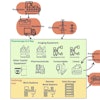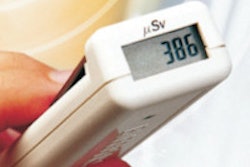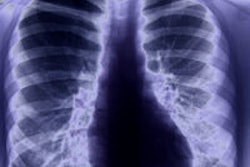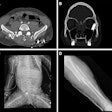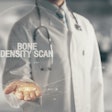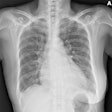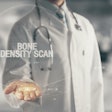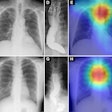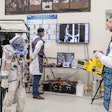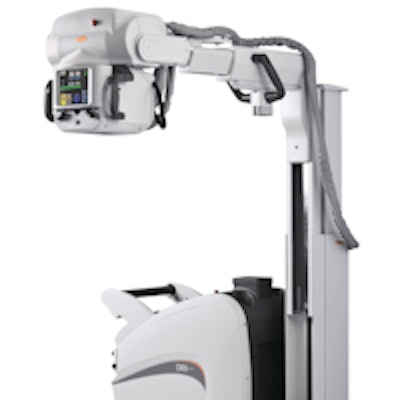
Researchers from Hong Kong were able to obtain mobile x-ray images in their PACS network 70% sooner using a wireless portable digital radiography (DR) unit rather than a mobile x-ray system equipped with computed radiography (CR) plates, according to a January 6 article in the Journal of Digital Imaging.
Images from a mobile DR unit sent via wireless LAN (WLAN) to a PACS were available a median of 6.8 minutes after the images were acquired, compared with 23 minutes for image availability when CR-based mobile units were used, the researchers found.
The sharp reduction in image-availability time improved workflow in the facility and also made images more accessible to referring physicians, meeting growing demands for more immediate access to medical images, according to lead author Dr. Tsz-Lung Ngan and colleagues from Hong Kong Sanatorium and Hospital (JDI, January 6, 2015).
Problems with portables
Portable imaging has always presented special challenges as radiology converts to digital imaging. The need to keep mobile x-ray systems in operation on the wards to image critically ill or bedridden patients creates delays in making images available on PACS networks. Converting analog mobile x-ray units to CR is only a minor improvement, as CR plates still have to be physically transported to a reader for digital conversion.
"The workflow bottleneck [is] the need for offsite processing of the x-ray-exposed CR cassette and transferring x-ray images to the PACS via wired Ethernet LAN in the radiology department," Ngan and colleagues wrote.
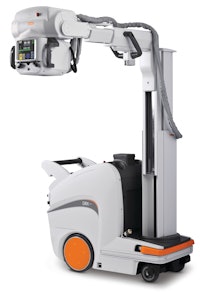 Carestream's DRX-Revolution wireless mobile DR system. Image courtesy of Carestream.
Carestream's DRX-Revolution wireless mobile DR system. Image courtesy of Carestream.At the same time, healthcare providers are demanding access to radiology images almost as soon as they are acquired, regardless of whether they're located within the radiology department with access to PACS workstations or are elsewhere in the institution employing Web-based viewing clients.
The new generation of mobile DR systems with wireless image transfer offers a solution to the problem, especially given the growing use of WLANs within healthcare institutions for transmitting medical data, the authors noted.
Ngan and colleagues had recently acquired a wireless DR system (DRX-Revolution, Carestream Health), and they decided to compare image availability times between the new system and an existing mobile radiography unit (Mobilett, Siemens Healthcare) outfitted with CR plates (Carestream).
Prior to performing the study, the group set up a Wi-Fi WLAN and connected it to the PACS network's wired Ethernet LAN. This enabled the mobile DR unit to wirelessly retrieve modality worklist data from a broker connected with the RIS, and also to wirelessly transmit DICOM 3.0 images and patient data to PACS or other destinations such as printers.
Setting up the network took some work: WLAN access points had to be installed throughout the hospital at locations where the mobile DR unit might be used. Some areas had weak wireless signal strength and had to be strengthened before the study began.
To ensure data security, the group adopted the Wi-Fi Protected Access 2 (WPA2) protocol, which requires authentication for the DR system and allows data encryption using the Advanced Encryption Standard (AES). What's more, the group ensured that only the DR unit could identify and recognize the specific Service Set Identifier (SSID) broadcasting from the WLAN access points. In addition to strengthening security, this ensured that DR image transfer wouldn't slow down data transfer for other wireless applications.
The group measured image-availability times for a total of 190 exams: 97 studies with the CR-equipped mobile x-ray system and 93 using the wireless DR unit. Image availability times were recorded from when the radiologic technologist started the exam to when the images were delivered and available in the PACS. The CR unit results were from March and April in 2012, while the DR system exams were from December of the same year.
Image-availability times were much faster with the DR system, at a mean interval of 6.8 minutes ± 2.6 minutes, compared with a mean interval of 23 minutes ± 10.2 minutes for CR (a difference of 16.2 minutes). DR studies were available as soon as two minutes for the quickest study to 13 minutes for the slowest, compared with a range of nine to 54 minutes for CR.
Ngan and colleagues also analyzed the particular workflow steps involved in producing images. Extra steps required by the CR system but not the wireless DR unit included processing cassettes and taking the elevator back from the wards to the radiology department. Also, with the DR system, all image postprocessing steps could be performed in the ward.
In analyzing the results, the researchers noted that the literature supports the idea that quicker access to images supports better workflow and, by extension, better patient care.
"By utilizing the WLAN-based [DR] portable radiography system, the workflow of portable radiography can not only be enhanced, the radiographer can also improve the efficiency of portable radiography by speedy delivery of digital radiological images and information to the clinicians for making timely diagnosis and treatment to the patients," they wrote.



